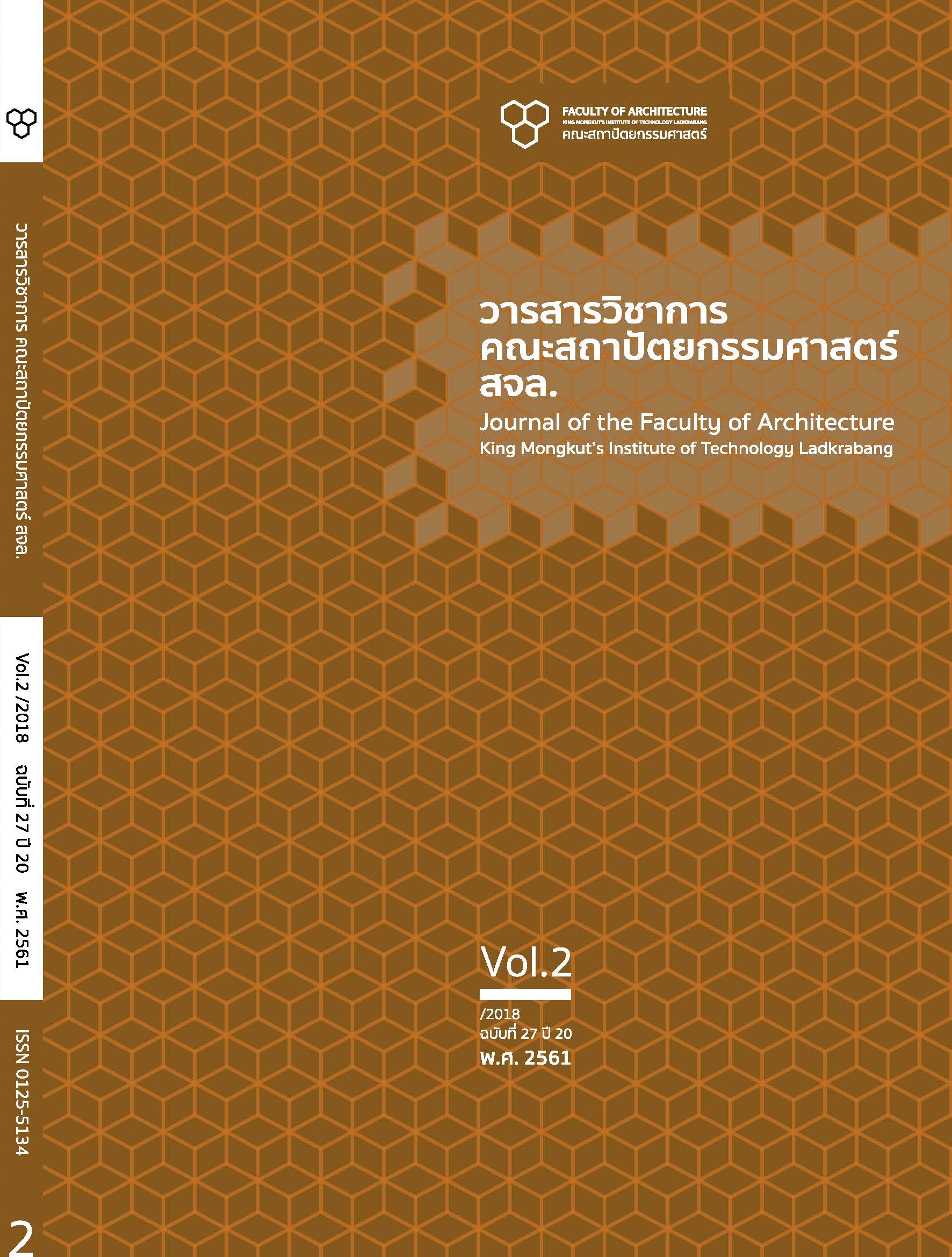การกำกับดูแลพื้นที่สาธารณะเมืองในฐานะทรัพยากรร่วม, Public Spaces Governance as a Common-Pool Resource
Main Article Content
Abstract
บทคัดย่อ
บทความนี้นำเสนอผลการทบทวนกรอบแนวคิดเรื่องการกำกับดูแลพื้นที่ในฐานะทรัพยากรร่วมโดยเน้นที่ความสัมพันธ์ระหว่างสิทธิสู่พื้นที่สาธารณะและความเป็นธรรมในการกำกับดูแล บทความแบ่งเป็น 3 ส่วน ได้แก่ กรอบแนวคิดเรื่องการกำกับดูแลทรัพยากรร่วม การกำกับดูแลพื้นที่สาธารณะเมืองในฐานะทรัพยากรร่วม และความเป็นธรรมในการกำกับดูแล ข้อสรุปสำคัญคือ แม้ว่าพื้นที่สาธารณะเมืองจะมีปัญหาพื้นฐานในลักษณะเดียวกันกับทรัพยากรร่วมประเภทอื่น ๆ คือ จำนวนผู้ใช้งานที่มากเกินไป การใช้ประโยชน์พื้นที่ด้วยวิธีการที่ไม่เหมาะสม และการไม่สามารถกีดกันผู้ใช้ประโยชน์คนอื่นที่ไม่ได้ร่วมแบ่งปันต้นทุนในการดูแลรักษาจะส่งผลทำให้ทรัพยากรมีไม่เพียงพอต่อความต้องการใช้งานหรือเกิดความเสื่อมโทรม แต่การกีดกันผู้ใช้ประโยชน์ออกจากพื้นที่โดยสิ้นเชิงก็ไม่ได้ส่งผลดีต่อการฟื้นฟูระบบทรัพยากรดังเช่นทรัพยากรร่วมประเภทอื่น ๆ เพราะพื้นที่สาธารณะเมืองเป็นทรัพยากรร่วมที่ต้องการรักษาความสมดุลระหว่างการถูกใช้ประโยชน์และการถูกกีดกัน จากการใช้ประโยชน์ วัตถุประสงค์สูงสุดของการกำกับดูแลพื้นที่สาธารณะจึงเป็นเรื่องของการรักษาคุณภาพและประสิทธิภาพของพื้นที่ให้สามารถตอบสนองต่อความต้องการใช้ประโยชน์ของกลุ่มคนในสังคมที่หลากหลายอย่างเท่าเทียมกัน ในขณะที่ยังคงรักษาความสมดุลระหว่างการถูกทิ้งร้างกับการถูกใช้งานอย่างแออัดในวิถีทางที่ไม่เหมาะสม ในเชิงข้อสรุปบทความนี้ยืนยันว่าภัยคุกคามที่สำคัญที่สุดของการกำกับ ดูแลพื้นที่สาธารณะเมืองคืออำนาจรัฐและระบบทุนนิยม เพราะสามารถส่งผลทำให้พื้นที่สาธารณะเมืองถูกแปลงเป็นสินค้าเอกชน ซึ่งจะทำให้เกิดการกีดกันสิทธิของคนออกจากพื้นที่ รวมถึงเกิดการแสวงหาผลประโยชน์เพื่อส่วนตัว ซึ่งผู้ที่จะได้รับผลกระทบสูงสุดเสมอก็คือกลุ่มคนที่ด้อยโอกาสในเมืองนั้นเอง
คำสำคัญ: พื้นที่สาธารณะเมือง ทรัพยากรร่วม การกำกับดูแล ความเป็นธรรม
Abstract
This paper presents the literature review of the concept of governing the urban public spaces as acommon-pool resource. The focus is on the relationship between the right to the public spaces and fairness in governance. The article is divided into 3 parts, 1) the conceptual framework of governing the common-pool resource, 2) public spaces governance as a common-pool resource, and 3) fairness in governance. The key conclusion is that even though urban public spaces are fundamentally problematic in the same way as other types of common-pool resources. That is, too many users, the use of space in the wrong way and the inability to exclude other users who do not share the cost of maintenance will result in inadequate resources for demand or degradation. But discouraging users from the area is not a good way to restore the quality of resource system, such as other types of common-pool resources. The public space requires balance between exploitation and exclusion. The ultimate goal of public space governance is to maintain the quality and efficiency of the area so that it can respond to the needs of the diverse population equally while maintaining a balance between abandonment and overcrowding in inappropriate ways. In summary this article insists that the most important threat to public space governance is state power and capitalism. This can result in public space being converted to private property, which will result in the exclusion of people from the area and the pursuit of personal interest. The people who are most affected are the underprivileged in the city itself.
Keywords: Urban Public Space, Common-Pool Resource, Governance, Fairne
Article Details
This work is licensed under a Creative Commons Attribution-NonCommercial-ShareAlike 4.0 International License.
Copyright Transfer Statement
The copyright of this article is transferred to Journal of The Faculty of Architecture King Mongkut's Institute of Technology Ladkrabang with effect if and when the article is accepted for publication. The copyright transfer covers the exclusive right to reproduce and distribute the article, including reprints, translations, photographic reproductions, electronic form (offline, online) or any other reproductions of similar nature.
The author warrants that this contribution is original and that he/she has full power to make this grant. The author signs for and accepts responsibility for releasing this material on behalf of any and all co-authors.
References
จุฑารัตน์ เอื้ออำนวย. (2556). ระบบยุติธรรมและยุติธรรมทางเลือก: แนวการวิเคราะห์เชิงสังคมศาสตร์. พิมพ์ครั้งที่ 1. กรุงเทพ: สานักพิมพ์แห่งจุฬาลงกรณ์มหาวิทยาลัย.
ชล บุนนาค. (2554). การสำรวจองค์ความรู้เรื่องแนวคิดว่าด้วยการจัดการทรัพยากรร่วม: ประสบการณ์จากต่างประเทศและแนวคิดในประเทศไทย. เข้าถึงได้จาก: https://v-reform.org/wp-content/uploads/2012/06/แนวคิดว่าด้วยการจัดการทรัพยากรร่วม.pdf.
ภิญญพันธุ์ พจนะลาวัณย์. (2558). กำเนิดประเทศไทยภายใต้เผด็จการ. กรุงเทพ: สำนักพิมพ์มติชน.
นิธิ เอียวศรีวงศ์. (2559). มหาวิทยาลัยกับห้างสรรพสินค้า. มติชนสุดสัปดาห์. (17 มิถุนายน 2559) กรุงเทพ: สำนักพิมพ์มติชน.
ศุภชัย ชัยจันทร์ และณรงพน ไล่ประกอบทรัพย์. (2560). แนวคิดสาธารณะของพื้นที่สาธารณะในเมือง. เข้าถึงได้จาก:
https://architservice.kku.ac.th/wp-content/uploads/2017/02/05-Supachai.pdf.
Benn, S. I. & Guas, G. F. (1983). Public and Private in Social life. New York: St. Martin’s Press.
Crawford, M. (1999). Blurring the Boundaries: Public Space and Private Life. Everyday Urbanism. New York: Monacelli Press.
Gehl, J. (2001). Life between Buildings. Using Public Spaces. Copenhagen: The Danish Architectural Press.
Graham, S. (2010). Cities under Siege: The New Military Urbanism. London: Verso.
Habermas, J. (1989). The Structural Transformation of the Public Sphere: An Inquiry into a Category of Bourgeois Society. Cambridge: MIT Press.
Hardin, G. (1968). The Tragedy of the Commons. Science. 162(3859), 1243-1248.
Harvey, D. (2005). The Political Economy of Public Space. Retrieved from: https://davidharvey.org/media/public.pdf.
Hess, C. (2008). Mapping the New Commons in the 12th Biennial Conference of the International Association for the Study of the Commons. England: University of Gloucestershire.
Lefebvre, H. (1991). The Production of Space. Oxford: Blackwell.
Mitchell, D. (2003). The Right to the City: Social Justice and the Fight for Public Space. New York: The Guilford Press.
Nemeth, J. (2012). Controlling the Commons: How Public is Public space? Urban Affairs Review. 48(6), 811-835.
Olson, M. (2002). The Logic of Collective Action: Public Goods and the Theory of Groups. Cambridge: Harvard University Press.
Ostrom, E. (1990). Governing the Commons. Cambridge: Cambridge University Press.
Ostrom, E. (2010). Beyond Markets and States: Polycentric Governance of Complex Economic Systems. American Economic Review. 100(3), 641-72.
Parkinson, J. R. (2012). Democracy and Public Space. USA: Oxford University Press.
Polko, A. (2012). Urban Public Spaces-from Economics to Management. Studia Regionalia. (34).
Rawls, J. (1971). Theory of Justice. Harvard, Harvard University Press.
Samuelson, P. A. (1954). The Pure Theory of Public Expenditure. The Review of Economics and Statistics.36(4), 178-179.
Scott, J. (1998). Seeing Like a State. New Haven: Yale University Press.
Sommer, R. (1989). Farmers' Markets as Community Events. In I. Altman and E. H. ZubeI (Eds.), Public Places and Spaces. (pp. 57-82). New York: Plenum Press.
Whyte, W. H. (1976). The Social Life of Small Urban Space. Washington DC: Conservation Foundation.


